Gilleleje: Denmark's seaside town that saved Danish Jews
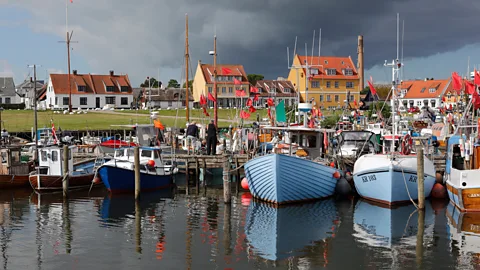 Robert Harding/Alamy
Robert Harding/AlamyThis October, a fishing town on the Danish Riviera remembers one of the greatest collective acts of resistance of World War Two: its role in the flight and escape of the Danish Jews.
It was autumn on the Danish Riviera, a string of fishing villages along the coast an hour north of Copenhagen. In the town of Gilleleje, apple trees hung heavy with fruit in the gardens of thatched cottages and pink roses bloomed in the dunes backing the long sand beach. Day trippers ate fish and chips on the quay next to a harbour packed with pleasure boats, and just under 10 nautical miles away, across a calm blue sea, the coast of Sweden hovered on the horizon.
It was an idyllic Scandinavian scene, but it hasn't always been this peaceful. Eighty years ago, in October 1943, this stretch of water represented an escape route for the Danish Jews. If they failed to cross the water from occupied Denmark to neutral Sweden, they faced deportation and possible death in the concentration camps of Europe.
Thanks to the bravery of the Danish people – and, in particular, the fishermen and people of Gilleleje and others along the Danish Riviera – 7,056 Danish Jews out of a total population of 7,800 were taken under the cover of darkness to Sweden and to freedom. It's hailed as one of the greatest acts of collective resistance during World War Two.
This October, Gilleleje is unveiling a new monument to mark the 80th anniversary; while a new exhibition at the Museum of Jewish Heritage in New York titled Courage to Act: Rescue in Denmark brings the story to a wider public.
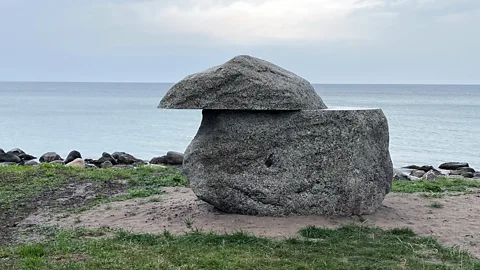 Laura Hall
Laura HallThis act of resistance began three and a half years into the German occupation of Denmark.
"In summer 1943, things were not going too well for Germany in the war," explained Lisa Tomlinson, a local tour guide who was showing me the town's historical sites via six memorial plaques, starting at the modest train station. "The Danish Resistance was getting more courageous and August saw strikes and sabotage across the country. Hitler decided to teach the Danes a lesson and ordered a roundup of Danish Jews in September to take place in early October."
She pointed out a shop once owned by a draper who displayed pro-RAF, anti-German posters as we walked past fisherman's cottages and the town's church. The Danish government had collaborated with the German regime initially, she explained, but after three and a half years, they had had enough. At the end of September, whispers were passed to politicians and rabbis that the Danish Jews should flee and do it quickly: the Nazis were due to round them up on the nights of 1 and 2 October. The safest route was to take the train to Gilleleje and find a passage across the Øresund Strait to Sweden.
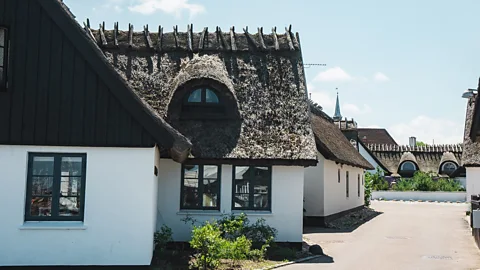 Nikolaj Danielsen/VisitNordsjælland
Nikolaj Danielsen/VisitNordsjællandIn 1943, Gilleleje was a fishing town with a population of around 1,700 where everyone knew each other. German soldiers were stationed at the nearby hotel and were visible on the town's streets and around the harbour. In addition, locals were on edge for impromptu visits from the Gestapo, stationed down the coast at Helsingør. They knew the risks they ran, but still they pulled together to help, meeting the fleeing Jews at train halts and taking them into hiding until nightfall when they could board boats for the dangerous two-hour trip on stormy windswept seas to Höganäs and other towns along the Swedish coast.
"There was something that Hitler had completely misunderstood," said Søren Frandsen the author of a new book, Kurs Mod Friheden (The Path To Freedom), about the events of October 1943. "And that was: while they were Jews, they were also Danish people. Of course, they would help each other in a crisis.
The responsibility to help others in peril was particularly ingrained in the religious fishing community of Gilleleje. Resilient and no strangers to danger, they innately knew the value of working together, creating a social network and banding together to help.
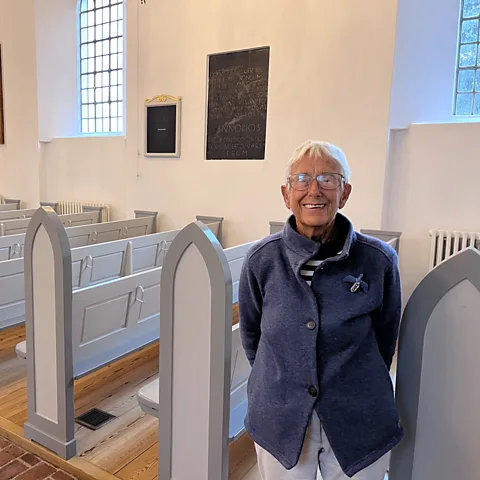 Laura Hall
Laura Hall"The attitude of the fishermen overall was that 'we help all people who are in need'," said Frandsen.
Led by the draper, the townsfolk mobilised quickly, finding safe houses, supplying food and blankets to people in hiding, and collecting money to help those who could not afford to pay for the journey. One of those was Tove Udsholt, just three years old at the time, who had arrived in Gilleleje with her mother and just a small bag filled with clothes and her teddy bear. Her mother had spent her last money on the train fare to Gilleleje – buying a return ticket to avoid suspicion.
"That was the only money my mum had," Udsholt said, now an 83-year-old, as she showed me around Gilleleje Church. "She hoped people would help. That's how it was."
Udsholt is one of the few remaining people alive at the time of the great flight, and gives regular talks and tours about her experiences. She was hidden with her mother and several others in a hay loft on Østergade, just a couple of streets from the church.
"Germans were patrolling the whole time," she said, "And I talked a lot. It was dangerous. A fisherman, Svend, came with food and blankets and saw me, and asked my mum if I could go home with him. She said yes, but that he had to bring me back."
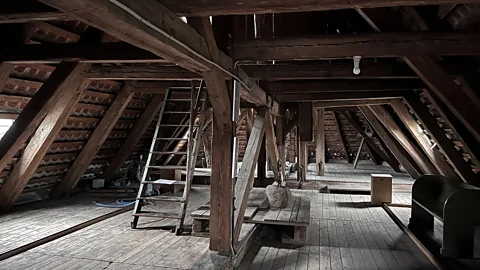 Laura Hall
Laura HallUdsholt went to play with the fisherman and his wife at their house on a neighbouring street while her mother sheltered in the hay loft until night fell and the conditions were good enough to sail to Sweden. While they were hiding, the Gestapo were alerted to a group of around 80 to 90 Jews hiding in the church attic and immediately arrested them, deporting them to Theresienstadt camp in Czechoslovakia. Standing in the present-day attic with Udsholt, with its bare boards and tiny windows with a view of the harbour, it was easy to imagine the panic and fear the group must have felt.
Upon hearing the news of the arrest of the church group up the street, Udsholt's group were told they had to leave immediately.
"My mother had just a second to make a decision," said Udsholt. "She had heard a rumour that if fishermen had children who cried or talked on board, the worst might happen to them. She told Svend that he and his wife could borrow me until the end of the war, but that she would come back to collect me then."
Udsholt spent the rest of the war in Gilleleje as one of 135 Jewish children hidden in Denmark and shielded from the German soldiers by the local people, at great risk to themselves. She remembers looking out over the water to the lights of Sweden to where her mother was, but after the war, reconciliation was difficult. She ended up staying with her foster family in the small beach town.
"Gilleleje looked after me," she said.
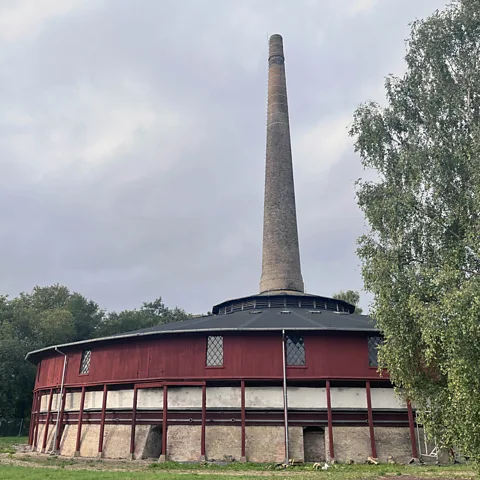 Laura Hall
Laura HallSimilar acts of courage took place up and down the coast throughout October 1943. In the town of Nivå, around 600 Danish Jews hid in the large kiln of a brickwork factory before escaping through the open marshlands under cover of night to waiting boats.
Jørgen Bertelsen is a volunteer guide at the kiln, and regularly takes school trips around it. "Nowadays there are many places where people need to flee," he said. "It's important to tell our kids about it so they will be more sympathetic to people who have to escape. It's not just happening in [places like] Africa: it happened here too. And we should also remember the volunteers who risked their lives to help."
For Udsholt , it's not just a story about wartime, but about celebrating an attitude towards people in need. "I think Gilleleje should be so proud that such a small town has achieved so much," she said. "It's not that people should be thanked for behaving with humanity – but we should be proud of this spirit. It's why it's important to open doors to Ukrainians and people fleeing war."
---
Join more than three million BBC Travel fans by liking us on Facebook, or follow us on Twitter and Instagram.
If you liked this story, sign up for the weekly bbc.com features newsletter called "The Essential List". A handpicked selection of stories from BBC Future, Culture, Worklife and Travel, delivered to your inbox every Friday.
